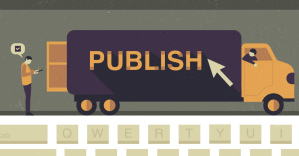Before You Click Publish, Here’s What to Do With Your Content



Arguably the hardest step of the writing process is putting down those first words and completing a first draft. But what's next? How does a business take the first draft of content to the next level? Editing is the clear next step, but there are a variety of other actions that can push the
Arguably the hardest step of the writing process is putting down those first words and completing a first draft. But what’s next? How does a business take the first draft of content to the next level? Editing is the clear next step, but there are a variety of other actions that can push the quality, shareability, and SEO even higher.
Content is exploding; every minute, we send approximately 204 million emails, make 2.46 million Facebook posts, and upload 72 hours of YouTube videos. So much content is produced every minute of the day that it’s almost impossible to measure. Authors and businesses have to compete for precious, distracted eyeballs. It’s easy to publish daily musings on the Internet, but unique content that’s impactful to a specific audience requires work and dedication. Most businesses are focused on articles, blog posts, and white papers. The following suggestions serve this type of content the best.
Here are some ways to improve your content:
Read the First Draft Out Loud
The best way to catch most common errors is to read the copy out loud. Whether it’s in front of someone or alone, turning content into speech brings out minor mistakes (like typos) as well as big picture stuff, such as clarity of structure and cohesion of writing. It’s incredibly important that an article communicates what an author intended. Each writer has ticks, energies, and common mistakes.
Ideally, the author will edit a piece before shipping it to an editor, content team, colleagues, or whoever takes care of it next. Considering each writer has their own unique style, it’s important for both the writer and editor to keep the brand’s voice in mind. If multiple authors write an article, a skilled editor can help bring the content together and solidify it.
Share the Content with Someone Outside of the Industry or Company
Content strategy should always start with a “why.” Any content produced by a business should have—and convey—a clear purpose that reflects the company or industry. Authors and publishers aren’t just responsible for the intent of their content—they are responsible for what the reader and greater audience get out of it. Sometimes the message is wildly different from what was intended. Showing your content to an out-of-company third party (or better yet, someone outside of the industry) can make sure the message is on point.
Include Relevant Keywords for SEO
Most brands generally go one of two ways with keyword optimization for SEO:
1) They don’t do it at all, and lose organic search traffic opportunity.
2) They overly optimize the page and the content comes across as meaningless gobbledygook to a human audience, which can then lose conversions. Additionally, search engines penalize sites for keyword stuffing.
Instead, a brand’s content should reflect a balance between light optimization and no optimization at all. There’s no magical formula for keyword optimization. However, there are some best practices to follow.
Keyword optimization is all about how an audience may find content on search engines. Individual search phrases are various and unique to speech patterns, languages, regional dialects, and other factors. These aspects of SEO may not be obvious to a particular author or top-of-mind when crafting a first draft. As search engines get smarter, they’re more able to predict searches and use natural language processing for comprehensive semantic understanding.
Add Image Alt Tags
Generally, each piece of content should include plenty of images to go along with the copy. Alt tags are code inside the img tag that displays either when a page’s images don’t load or if they are being read by another computer (either a screenreader for accessibility or a search engine bot indexing a site). For best accessibility and SEO practice, add alt tags to every image to explain it.
Add Relevant Links
A single piece of content can’t cover everything. Time to retire titles like “The Ultimate Guide to Better Customer Relationships.” There’s really no such thing as a completely comprehensive guide, so it makes sense for a brand to link out for further information, deeper dives, or relevant tangents.
Links to other brands and key influencers can also solidify and build relationships. Backlinks are important for SEO and brand authority. Adding a link acts as an endorsement of that content. It’s also an easy way to encourage those other brands and influencers to share the finalized published content.
Prompt Readers to Share Socially
Social media share buttons are already a must for any piece of content. They should be tailored to a brand’s industry and the social networks that are expected to drive the most traffic. For example, a B2B company may find LinkedIn has a larger sharing potential for their audience, whereas a self-confessional blogger brand may have a larger impact on Facebook or even Tumblr.
To take it a step further, mobilize the audience to share while they’re reading. Many sites choose to employ share buttons, which follow the page scroll on the sidebar. Others specifically call out text—usually either to tweet or email—and some will let a reader highlight any text and share that. All these features are typically fairly easy to implement with JavaScript.
Code in Open Graph Tags and Twitter Cards
If it’s important to remind readers to share, it’s extra important to make sure the content is optimized for sharing. By adding open graph tags and Twitter cards, a business ensures its content is ready for social sharing. The code goes into the HTML head section.
Many content management systems used for content creation have plugins or places to enter in this code. A brand can take this code further by specifying different content titles tailored to different social media outlets. Many news companies do this because a title that may attract visitors on Facebook may not have the same effect on Twitter. For example, an article about parenting may tell the Facebook reader “You’ll Never Believe What My 6-Year-Old Did.” However, on Twitter, the brand may want to hone in on a target audience based on the article being about a 6-year-old unintentionally body shaming her mother and incorporate the body love hashtag #NewYearNewView into the title.
Credit the Author with a Headshot and Bio
Content creation doesn’t happen in a void, so a brand should make sure to give credit to the main author(s). This encourages the author to promote the piece and remain engaged on social media and the commenting section. Additionally, authorship adds authority and legitimacy. People trust people, especially experts in their niche. Content created by a real person, instead of just credited to a brand, provides an extra boost of trust and sincerity.
Besides giving an author credit, a bio can also explain to an audience why a brand enlisted a specific person to write on each topic. Furthermore, it gives the audience information about how they can find the author outside of a particular piece of content.
Now the content is ready for publishing, but there are still some key steps to complete immediately after it goes live.
Inform the Author and Brand Social Media Teams of Publishing
Don’t forget to let the author know the content was published. It’s even better if a brand can send along the final title and URL. The author will probably want to share their work on social media, in email newsletters, or in other outlets at their disposal.
Also, don’t forget to inform an in-house social media team. They are there to support the company. Make sure to send the final title and URL once a final content publication date is set. Try using the following template to help:
Got Comments? Moderate Them
If a brand allows commenting, those comments need to be moderated with a clear policy with expectations for commenter behavior and consequences for violation. Unmoderated comments often become cesspools and may turn off readers. Comment moderation can increase engagement on the site. One brand found by simply moderating comments, page views per visit increased by 10 percent, return visits grew by 20 percent, and visits of two pages or more increased by almost 20 percent.
Don’t expect the author to moderate comments, but authors should be encouraged—and sometimes may need prompting—to answer with quality comments. Audiences are thrilled when the expert joins into the discussion to give further insights on the topic.
Community and/or content teams tasked with comment moderation should be empowered by a brand in their task. Clear policies assist the job, and if unhappily moderated readers complain to a brand’s support team, managers, or even CEOs, brands should back up their employees.
The Full Power of Content
Content from soup to nuts is more than just writing a first draft. Dedication to editing and the rest of the pre- and post-publication details will push a brand’s content further than its competitors. Great content connects with readers. Those details boost reach, shareability, SEO, relatability, authority, and more.
For a brand, getting eyeballs onto a piece of content with a clear message is priceless. Just like it’s silly to head out into a snowstorm without boots, a jacket, and mittens, content shouldn’t be released into the wild without support and proper attention.
Share Before You Click Publish On Your Site
About the Author
 Erica McGillivray spends a ridiculous amount of time being geeky, both professionally and personally. At Moz, she’s the senior community manager, wrangling 500,000+ people and co-running their annual conference MozCon. Erica also is a founder of GeekGirlCon, is a published author, and has a comic book collection that’s an earthquake hazard. Follow her at @emcgillivray.
Erica McGillivray spends a ridiculous amount of time being geeky, both professionally and personally. At Moz, she’s the senior community manager, wrangling 500,000+ people and co-running their annual conference MozCon. Erica also is a founder of GeekGirlCon, is a published author, and has a comic book collection that’s an earthquake hazard. Follow her at @emcgillivray.



























